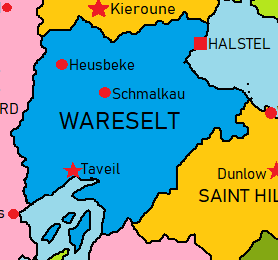Wareselt
Republic of Wareselt | |
|---|---|
|
Flag | |
 | |
| Capital | Taveil |
| Largest city | Halstel |
| Government | |
| Wesley Bonaparte | |
| Establishment | |
• Kingdom of Warehilley | 1321 |
| 1805 | |
• Republic of Warehilley | 1880 |
• Republic of Wareselt | 1928 |
| Population | |
• 2024 estimate | 9,061,000 |
| Date format | mm-dd-yyyy |
The Republic of Wareselt is a country in northeast Nortua, bordered to the north by Eastern Holin, to the west by Tine, to the south by Kamani, and to the west by Saint Hilley. It also shares maritime borders with Candatora by Bremic Lake, and the Arenoran Isles by the Strait of Mitter. Wareselt has a population of roughly 9.1 million people. Its capital is Taveil, its largest city is Halstel, and other major cities include Schmalkau and Heusbeke. Wareselt has a varied terrain, ranging from high plains along with rolling hills and mountains, some of which reach an altitude of over 1,250 m (3,600 ft), to low plains along the northeast coast and southern lakelands.
The area of modern day Wareselt was long populated by indigenous Nortuans and the kingdoms of various empires throughout history. The concept of Wareselt as its own distinct culture emerged around the 1300s with the establishment of the kingdom of Warehilley, which occupied its own territory along the Mitter. Warehilley was incorporated into the Nortuan Union in 1805. Upon the dissolution of the Union, Warehilley became an independent republic in 1880. In 1928, Saint Hilley peacefully broke away from Wareselt in a democratic referendum, and the two maintain strong political and cultural ties.
Wareselt is a developing country, with an upper-middle-income economy. Wareselt is dominated by the services sector, accounting for 54% of GDP and employing approximately 56.6% of the population. It has experienced solid economic growth over the last decade. It has large reserves of lead, zinc, silver, nickel, cobalt, copper, iron and bauxite. 53% of the nation's area is agricultural land, 41% forest and forestry land, and 6% for others. Wareselt is a member state of several international organizations, including the CCA, ANS, and CTO.
History
Ancient history
Middle ages
Kingdom of Warehilley
Nortuan Union
Republic
Independent Wareselt
Geography
Climate
Flora and fauna
Politics and government
Wareselt is a representative parliamentary democratic republic. According to the current Constitution of Wareselt, the President is the head of state holding largely representational functions, while the Prime Minister is the head of government and exercises executive power.
Foreign relations
Military
The Wareselt Army, Navy, and Air Force are the three branches of the Armed Forces of Wareselt. The military doctrine was formed after the collapse of the Nortuan Union in 1880, and was reestablished after the split of Warehilley and with the establishment of the Ministry of Defence in 1929. The Commander-in-Chief of the military is the Prime Minister of Wareselt. The Ministry of Defence is in charge of political leadership, while military command remains in the hands of the general staff.
Active forces now number about 81,000 soldiers, with an additional reserve of 32,000 troops. Wareselt border guards are in charge of patrolling the country's borders. In the case of conscription, Wareselt is able to mobilize every able-bodied man between the age of 15 and 59, with military preparedness.

